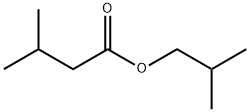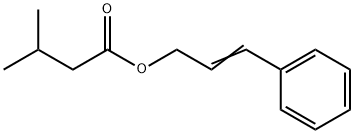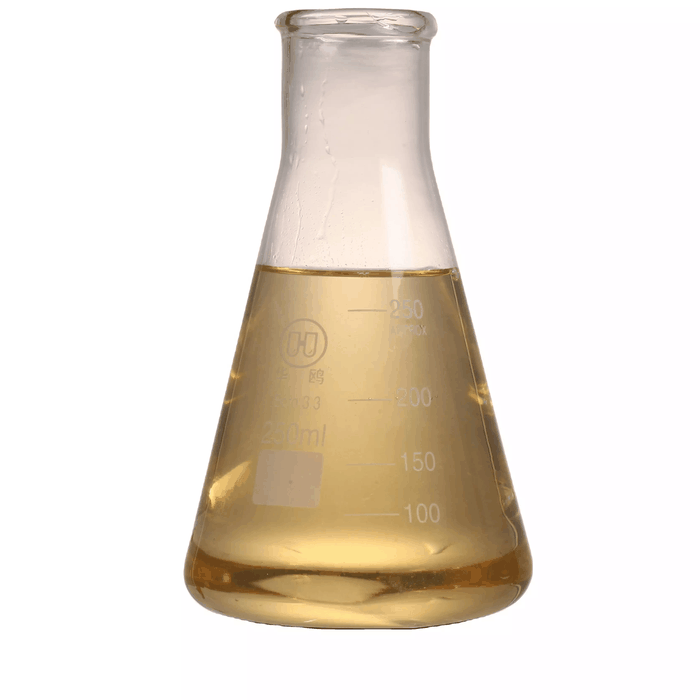Ethyl isovalerate
- CAS NO.:108-64-5
- Empirical Formula: C7H14O2
- Molecular Weight: 130.18
- MDL number: MFCD00009203
- EINECS: 203-602-3
- SAFETY DATA SHEET (SDS)
- Update Date: 2024-12-18 14:15:32

What is Ethyl isovalerate?
Chemical properties
clear colorless to pale yellowish liquid
Chemical properties
Ethyl Isovalerate is a colorless liquid with a fruity odor reminiscent of blueberries. It occurs in fruits, vegetables, and alcoholic beverages. It is used in fruit aroma compositions.
Chemical properties
Ethyl isovalerate has a strong, fruity, vinous, apple-like odor on dilution.
Occurrence
Reported found in pineapple, orange juice and peel oil, bilberry, blueberry, strawberry, Swiss cheese, other cheeses, beer, cognac, rum, cider, whiskey, sherry, grape wines, cocoa, passion fruit, mango and mussels.
The Uses of Ethyl isovalerate
In alcohol solution for flavoring confectionery and beverages.
Definition
ChEBI: The fatty acid ethyl ester of isovaleric acid.
Preparation
By esterification of isovaleric acid with ethyl alcohol in the presence of concentrated H2SO4.
Production Methods
Ethyl isovalerate is produced by combining isovaleric acid and ethanol in the presence of concentrated sulfuric acid or hydrochloric acid ester followed by distillation .
Aroma threshold values
Detection: 0.01 to 0.4 ppb
Taste threshold values
Taste characteristics at 30 ppm: fruity, sweet, estry and berry-like with a ripe, pulpy fruity nuance.
General Description
A colorless oily liquid with a strong odor similar to apples. Less dense than water. Vapors heavier than air. Flash point 77°F. May mildly irritate skin and eyes.
Air & Water Reactions
Highly flammable. Slightly soluble in water.
Reactivity Profile
ETHYL ISOVALERATE is an ester. Esters react with acids to liberate heat along with alcohols and acids. Strong oxidizing acids may cause a vigorous reaction that is sufficiently exothermic to ignite the reaction products. Heat is also generated by the interaction of esters with caustic solutions. Flammable hydrogen is generated by mixing esters with alkali metals and hydrides.
Health Hazard
Inhalation or contact with material may irritate or burn skin and eyes. Fire may produce irritating, corrosive and/or toxic gases. Vapors may cause dizziness or suffocation. Runoff from fire control or dilution water may cause pollution.
Carcinogenicity
Not listed by ACGIH, California Proposition 65, IARC, NTP, or OSHA.
Purification Methods
Wash the ester with aqueous 5% Na2CO3, then saturated aqueous CaCl2. Dry it over CaSO4 and distil. [Beilstein 2 IV 898.]
Properties of Ethyl isovalerate
| Melting point: | -99 °C (lit.) |
| Boiling point: | 131-133 °C (lit.) |
| Density | 0.864 g/mL at 25 °C (lit.) |
| vapor pressure | 7.5 mm Hg ( 20 °C) |
| refractive index | n |
| FEMA | 2463 | ETHYL ISOVALERATE |
| Flash point: | 80 °F |
| storage temp. | Flammables area |
| solubility | 2.00g/l |
| form | Liquid |
| color | Clear colorless to pale yellow |
| Odor | at 10.00 % in dipropylene glycol. fruity sweet apple pineapple tutti frutti |
| Odor Threshold | 0.000013ppm |
| Water Solubility | 1.76g/L at 20℃ |
| JECFA Number | 196 |
| Merck | 14,3816 |
| BRN | 1744677 |
| Dielectric constant | 4.7(18℃) |
| Stability: | Volatile |
| CAS DataBase Reference | 108-64-5(CAS DataBase Reference) |
| NIST Chemistry Reference | Butanoic acid, 3-methyl-, ethyl ester(108-64-5) |
| EPA Substance Registry System | Ethyl isovalerate (108-64-5) |
Safety information for Ethyl isovalerate
| Signal word | Warning |
| Pictogram(s) |
 Flame Flammables GHS02 |
| GHS Hazard Statements |
H226:Flammable liquids |
| Precautionary Statement Codes |
P210:Keep away from heat/sparks/open flames/hot surfaces. — No smoking. P240:Ground/bond container and receiving equipment. P241:Use explosion-proof electrical/ventilating/lighting/…/equipment. P303+P361+P353:IF ON SKIN (or hair): Remove/Take off Immediately all contaminated clothing. Rinse SKIN with water/shower. |
Computed Descriptors for Ethyl isovalerate
Ethyl isovalerate manufacturer
Silverline Chemicals
New Products
(S)-3-Aminobutanenitrile hydrochloride 4-Methylphenylacetic acid N-Boc-D-alaninol N-BOC-D/L-ALANINOL Tert-butyl bis(2-chloroethyl)carbamate N-octanoyl benzotriazole 3-Morpholino-1-(4-nitrophenyl)-5,6-dihydropyridin- 2(1H)-one Furan-2,5-Dicarboxylic Acid S-2-CHLORO PROPIONIC ACID ETHYL ISOCYANOACETATE 2-Bromo-1,3-Bis(Dimethylamino)Trimethinium Hexafluorophosphate 4-IODO BENZOIC ACID 3-NITRO-2-METHYL ANILINE 1-(2,4-DICHLOROPHENYL) ETHANAMINE (2-Hydroxyphenyl)acetonitrile 4-Bromopyrazole 5,6-Dimethoxyindanone 2-(Cyanocyclohexyl)acetic acid 4-methoxy-3,5-dinitropyridine 1-(4-(aminomethyl)benzyl)urea hydrochloride 2-aminopropyl benzoate hydrochloride diethyl 2-(2-((tertbutoxycarbonyl)amino) ethyl)malonate tert-butyl 4- (ureidomethyl)benzylcarbamate Ethyl-2-chloro((4-methoxyphenyl)hydrazono)acetateRelated products of tetrahydrofuran








You may like
-
 108-64-5 ETHYL ISO VALERATE 99%View Details
108-64-5 ETHYL ISO VALERATE 99%View Details
108-64-5 -
 108-64-5 99%View Details
108-64-5 99%View Details
108-64-5 -
 Ethyl Isovalerate 98%View Details
Ethyl Isovalerate 98%View Details
108-64-5 -
 Ethyl Isovalerate CAS 108-64-5View Details
Ethyl Isovalerate CAS 108-64-5View Details
108-64-5 -
 Ethyl isovalerate, 99% CAS 108-64-5View Details
Ethyl isovalerate, 99% CAS 108-64-5View Details
108-64-5 -
 Ethyl iso-Valerate CAS 108-64-5View Details
Ethyl iso-Valerate CAS 108-64-5View Details
108-64-5 -
 Ethyl isovalerate CAS 108-64-5View Details
Ethyl isovalerate CAS 108-64-5View Details
108-64-5 -
 118753-70-1 98+View Details
118753-70-1 98+View Details
118753-70-1